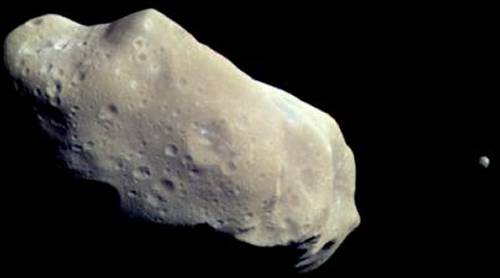Asteroids
Asteroids, along with comets, represent the material left over after the formation of the planets. They are found throughout the Solar System, but the largest concentration occurs between the orbits of Mars and Jupiter, in the Asteroid Belt. Asteroids have highly variable consistencies. The relative amounts of rocky and metallic material contained in asteroids allows us to form a classification scheme. Their position in the Solar System relative to the Sun and orbits of the planets also allows us to classify them spatially.
The image below of asteroid 243 Ida (and its companion satellite Dactyl), was taken by Galileo when it encountered the asteroid on 28th August 1993.

[ NASA / JPL / Caltech ]
Mineralogical classification
The surface material of asteroids shares very similar compositions to those of meteorites, so it is believed that meteorites originate from broken-up asteroids. In turn, asteroids are believed to be the remnants of large planetesimals (similar in size to Mars) which collided early in the Solar System's existence. To see compositional information about asteroids, see the Meteorite page.
Orbital classification
Near Earth Asteroids (or NEAs) can be divided into three groups based upon their orbital characteristics :-
- Apollo group: bodies orbiting mostly outside that of the Earth. Type asteroid: Apollo-1862 (discovered 1932).
- Aten group: bodies orbiting mostly within that of the Earth. Type asteroid: Aten-2062 (discovered 1976).
- Amor group: bodies orbiting outside the Earth's orbital path (i.e. with perihelions greater than 1 AU). Type asteroid: Amor-1221 (discovered 1932).
Most Apollo group objects seem to have a characteristically chondritic composition, and are also relatively small objects of only a few kilometers across, similar to Aten group objects. There are several other divisions of asteroids including the following (Illingworth, 1994.):-
- Martian Trojans: only two of these objects are known.
- Jovian Trojans: minor bodies constrained to the Lagrangian points on the orbital path of Jupiter, 60° behind and 60° ahead of the planet. They are characteristically very dark objects although many have been observed. There is a large number of objects in this group. Type asteroid: Achilles (discovered 1906).
- Jupiter-crossers: orbits that cross the path of Jupiter, and are thus very short-lived.
- Centaurs: orbit between Jupiter and Neptune. They are basically minor planets such as 95P/Chiron, which has a semimajor axis of 13.7 Astronomical Units (AU) and an eccentricity of 0.38. See this page for more info on Chiron.
- Trans-Neptunians: see the Kuiper Belt page.
Missions to asteroids
Spacecraft have been sent to study asteroids. These include Galileo, which visited 951 Gaspra and then 243 Ida on its way to Jupiter, and the Near Earth Asteroid Rendezvous (NEAR) spacecraft, which was sent to study Eros. Galileo imaged the first known asteroid (243 Ida) to have its own natural satellite, the 1.5 km diameter Dactyl.
Clementine was to have visited the NEA Geographos on 31st August 1994 after its lunar mapping mission. Unfortunately, two days after leaving lunar orbit a malfunction on 7th May 1994 caused the spacecraft to fire its altitude thrusters which used up its remaining fuel and prevented the encounter from taking place.
The more recent mission Deep Space 1 was sent to visit asteroid 9969 Braille, and passed within 26 km of it on 28th July 1999, after a course correction following the discovery that the asteroid was more than 430 km from its calculated position only 2 days prior to the encounter. Another mission called MUSES-C (incorporating the MUSES-CN Asteroid Rover), due for launch in 2002, is the first asteroid sample-return mission, and plans to land a small rover on asteroid 4660 Nereus.